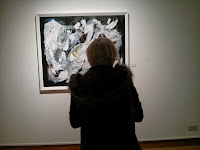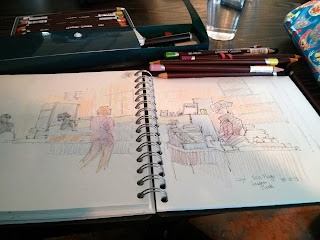 |
| Mary Kemp. Blakeney Church. |
 |
| Mary Kemp. Blakeney Church. nearly finished. |
 |
| Mary Kemp. Paintings started during "Live Art" at Art in the Heart , Peterborough. |
| Mary Kemp. Poinsettia in the Kitchen. |
 |
| Windsor and Newton Acrylic White Gesso |
 |
| Sue Shields - Painting. |
 |
| Sue Shields with copper work ready for photos. |
| Painting kit. |
 |
| Mary Kemp - Poppy Field Last Summer. Oil on canvas 30 x 30 cms. |
| Mary Kemp - On the Rocks. x2 |
 |
| Mary Kemp - Drawing of a Field. |
 |
| Mary Kemp - Filing system? |
 |
| Sainsbury's Centre UEA |
 |
| Mary Kemp - Cafe Sketch |
 |
| Mary Kemp - "I'm at the Seaside With the Children" Acrylic on canvas panel 30 x 30 cms. |
| My studio, not perfect but pretty good. |
 |
| The Island of Adventure by Enid Blyton, illustrated by Tony Soper, one of my favourite childhood reads. |
 |
| Mary Kemp - Not Here - Not Now. oil on canvas panel 30 x 30 cms |
 |
| Mary Kemp - Beach Scene - oil on canvas 30 x 30 |
 |
| Mary Kemp - Beach Scene - early drawings |
 |
| Jean Edwards - Colours of the Landscape. Watercolour. |
 |
| Frank Auerbach Head of EOW IV National Gallery of Scotland |
 |
| Mary Kemp - Ferns |
 |
| Mary Kemp - Ferns. |
 |
| Mary Kemp - Forest Path oil on board 50 x 40 cms |
 |
| Mary Kemp - Forest Path , oil on board 50 x 40 cms. |
 |
| Picture 3 - Mary Kemp - Forest Floor |
 |
| Picture One. Mary Kemp . Forest Floor |
 |
| Picture Two. Mary Kemp. Forest Floor |
 |
| Mary Kemp - Houses Through the Trees. Oil on board 70 x 50 cms. |
 |
| Mary Kemp - Eastfield Allotment - oil on canvas 60 x 30cms |
 |
| Mary Kemp - Trees at Ferry Meadows Cafe. Oil on canvas panel 30 x 30 |
| Transparent Earth Red and Brown Pink |
| No ! No ! No ! |
 Being a starving artist I am a bit cautious about where I spend my money. I want value for money, which is why after attending a very successful two day course a few years ago at the Norfolk Painting School of Martin Kinnear I decided it was time I invested some more of my hard earned cash in a few days of training .
Being a starving artist I am a bit cautious about where I spend my money. I want value for money, which is why after attending a very successful two day course a few years ago at the Norfolk Painting School of Martin Kinnear I decided it was time I invested some more of my hard earned cash in a few days of training .  |
| Vanda - studio assistant. |
 I feel these three days have influenced my work no end. There was a lot of theoretical information which made sense of the methods and materials we were using. We were well fed, our pallettes were cleaned! and the atmosphere was business like and friendly.
I feel these three days have influenced my work no end. There was a lot of theoretical information which made sense of the methods and materials we were using. We were well fed, our pallettes were cleaned! and the atmosphere was business like and friendly. 
| Mary Kemp - Autumn at the Allotment, Last Year. |
| Mary Kemp - Woman on the beach. Pen and coloured pencils in sketchbook. |
Dear fellow art lovers, I'm often asked by busy customers how to look after their prints once they've bought them. Prints are a ...
